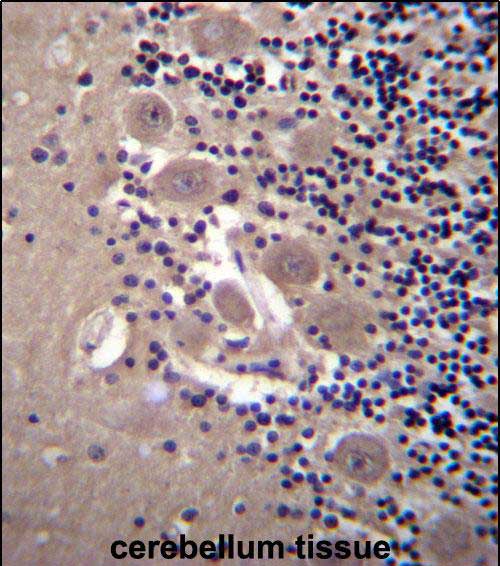NPTXR Antibody (Center)
Affinity Purified Rabbit Polyclonal Antibody (Pab)
- SPECIFICATION
- CITATIONS
- PROTOCOLS
- BACKGROUND

Application
| IHC-P, WB, E |
|---|---|
| Primary Accession | O95502 |
| Other Accession | NP_055108.2 |
| Reactivity | Human |
| Host | Rabbit |
| Clonality | Polyclonal |
| Isotype | Rabbit IgG |
| Calculated MW | 52846 Da |
| Antigen Region | 180-209 aa |
| Gene ID | 23467 |
|---|---|
| Other Names | Neuronal pentraxin receptor, NPTXR |
| Target/Specificity | This NPTXR antibody is generated from rabbits immunized with a KLH conjugated synthetic peptide between 180-209 amino acids from the Central region of human NPTXR. |
| Dilution | IHC-P~~1:10~50 WB~~1:1000 E~~Use at an assay dependent concentration. |
| Format | Purified polyclonal antibody supplied in PBS with 0.09% (W/V) sodium azide. This antibody is purified through a protein A column, followed by peptide affinity purification. |
| Storage | Maintain refrigerated at 2-8°C for up to 2 weeks. For long term storage store at -20°C in small aliquots to prevent freeze-thaw cycles. |
| Precautions | NPTXR Antibody (Center) is for research use only and not for use in diagnostic or therapeutic procedures. |
| Name | NPTXR |
|---|---|
| Function | May be involved in mediating uptake of synaptic material during synapse remodeling or in mediating the synaptic clustering of AMPA glutamate receptors at a subset of excitatory synapses. |
| Cellular Location | Membrane; Single-pass type II membrane protein |

Thousands of laboratories across the world have published research that depended on the performance of antibodies from Abcepta to advance their research. Check out links to articles that cite our products in major peer-reviewed journals, organized by research category.
info@abcepta.com, and receive a free "I Love Antibodies" mug.
Provided below are standard protocols that you may find useful for product applications.
Background
This gene encodes a protein similar to the rat neuronal pentraxin receptor. The rat pentraxin receptor is an integral membrane protein that is thought to mediate neuronal uptake of the snake venom toxin, taipoxin, and its transport into the synapses. Studies in rat indicate that translation of this mRNA initiates at a non-AUG (CUG) codon. This may also be true for mouse and human, based on strong sequence conservation amongst these species.
References
Rose, J. Phd, et al. Mol. Med. (2010) In press :
Yin, G.N., et al. Brain Res. 1265, 158-170 (2009) :
Andersson, K.B., et al. Acta Physiol (Oxf) 186(1):17-27(2006)
Poulsen, T.T., et al. Lung Cancer 50(3):329-337(2005)
Kirkpatrick, L.L., et al. J. Biol. Chem. 275(23):17786-17792(2000)
If you have used an Abcepta product and would like to share how it has performed, please click on the "Submit Review" button and provide the requested information. Our staff will examine and post your review and contact you if needed.
If you have any additional inquiries please email technical services at tech@abcepta.com.













 Foundational characteristics of cancer include proliferation, angiogenesis, migration, evasion of apoptosis, and cellular immortality. Find key markers for these cellular processes and antibodies to detect them.
Foundational characteristics of cancer include proliferation, angiogenesis, migration, evasion of apoptosis, and cellular immortality. Find key markers for these cellular processes and antibodies to detect them. The SUMOplot™ Analysis Program predicts and scores sumoylation sites in your protein. SUMOylation is a post-translational modification involved in various cellular processes, such as nuclear-cytosolic transport, transcriptional regulation, apoptosis, protein stability, response to stress, and progression through the cell cycle.
The SUMOplot™ Analysis Program predicts and scores sumoylation sites in your protein. SUMOylation is a post-translational modification involved in various cellular processes, such as nuclear-cytosolic transport, transcriptional regulation, apoptosis, protein stability, response to stress, and progression through the cell cycle. The Autophagy Receptor Motif Plotter predicts and scores autophagy receptor binding sites in your protein. Identifying proteins connected to this pathway is critical to understanding the role of autophagy in physiological as well as pathological processes such as development, differentiation, neurodegenerative diseases, stress, infection, and cancer.
The Autophagy Receptor Motif Plotter predicts and scores autophagy receptor binding sites in your protein. Identifying proteins connected to this pathway is critical to understanding the role of autophagy in physiological as well as pathological processes such as development, differentiation, neurodegenerative diseases, stress, infection, and cancer.



